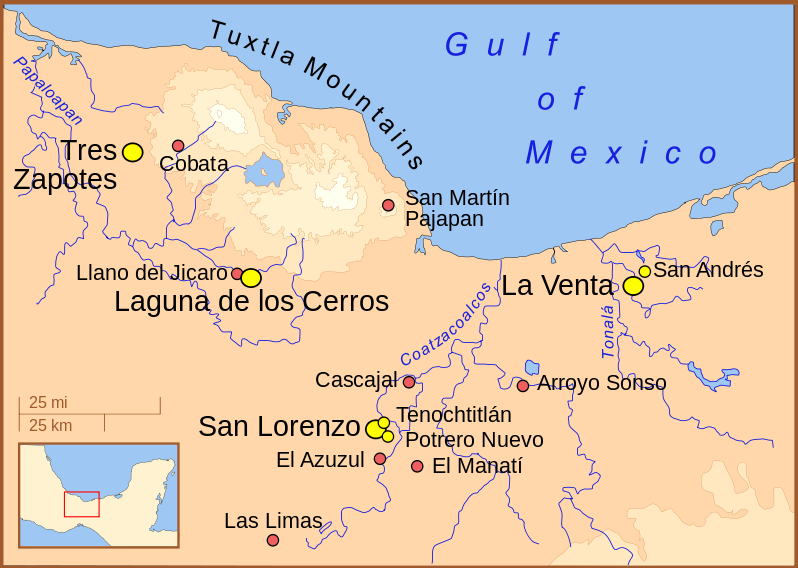While studying the Olmec people, the earliest known Mesoamerican civilization, we come to find out how little we know about this ancient civilization. In the video entitled Lost Kingdoms of Central America and the article entitled "La Venta" from Archaeology of Ancient Mexico and Central America: An Encyclopedia, by Rebecca Gonzalez Lauck, we see how both of these give us information about the Olmecs, one focusing on their environment and the other focusing on the architecture of La Venta, an ancient settlement and now an archaeological site. The video goes into detail about how the Olmecs survived in the environment they did and how they believed in and worshipped supernatural beings. While the video summarizes a little bit about everything of the Olmec people, the article merely focuses on the findings of La Venta. Lauck states, “One of the most remarkable offerings excavated in this precinct consisted of a group of sixteen figurines and reworked votive celts, carved in jade, serpentine, and sandstone” (Gonzalez Lauck 800). We see that the article talks about offerings that were found at the site. It focuses on what has been excavated at the archeological site and doesn’t mention the environment around it. Whereas the video states, “...these wooden representations of the Olmec weren’t for public display. Instead, they were deliberately thrown into the waters of a bog” (Lost 23:06-23:16). As the narrator goes on to show us wooden carved figurines, he tells us that they were thrown into the bog, the environment around them, as it then states, “They were cast in as an offering to the spirit world” (Lost 23:22-23:26). If we want more information on who the Olmecs were, we would go to the video. But, if we wanted information on how they built their settlement, La Venta, we would read the article.
 |
| A King or Chief found at La Venta |
As we focus on the theme of religion between the video and the article, we find that these two sources are similar in stating what the Olmecs believed in, while also differing as one centers on the environment and the other on a settlement. Lauck again talks about what was found as they excavated La Venta as she states, “A third example is a group of six stela-like sculptures distributed along the southern base of the main pyramid. Four of these, carved in low relief, share the theme of representations of supernatural beings… These sculptures constitute one of the earliest examples in ancient Mexico of large-scale ideological communication through the interaction of architecture and sculpture” (Gonzalez Lauck 800). She shows us how the Olmecs made sculptures of the supernatural beings that they believed in. She also lets us know that these sculptures are examples of how the Olmecs communicated with the other world through these sculptures and the architecture of La Venta. While the article again centers on La Venta, the video shows us how the Olmecs created offerings with their environment to communicate with their supernatural beings. It states, “Rubber trees were found in the area where jaguars lived. Jaguars represented fertility and so the area was very important” (Lost 26:08-26:15). Jaguars were sacred to the Olmecs. So, finding rubber trees where jaguars lived, the Olmes believed that rubber was important to the jaguars. Rubber was then molded into a ball to give as an offering to the jaguars, one of the supernatural beings they believed in. We see that the article talks about how the Olmecs communicate through sculptures and architecture, whereas the video shows us how the Olmecs communicate through the environment around them.
 |
| A map of the Olmec heartlands |
As we come to a wrap on the video and the article, we see that these both give incredible information on the Olmec, even if they do focus on differing topics. In the article, Lauck tells us how important the excavation of the sculptures is as she states, “Based on the sculptural art, we can propose that the supernatural world played an important role among the ruling sector” (Gonzalez Lauck 800). Because of the sculptures and their showcasing of what the Olmecs thought to be important, we can get a better understanding of these ancient people and how they ruled based on what they believed in. In the lessons before this, I learned how important sculptures were to the Olmecs, as we learn the hard work it took to transfer huge stones of volcanic rock some 50 miles in order to carve a face into it. The video, differing from the article, shows us how important the land around the Olmecs was based on offerings found in the water as it states, “To the Olmec, bodies of water were entranceways to the underworld and to break its surface is to enter into another dimension” (Lost 24:01-24:08). The findings of offering in bogs and bodies of water showcase how large of a role the land around them played. And as we learned about the Olmecs again in earlier lessons, I also know how important water was to them. As they believed it to be a life-giving source. As the article mentions sculptural art, the video mentions the land around the Olmecs. Both on the subject of religion, but each one gives new and interesting information. For more information about the Olmec culture, I suggest watching this video:
BBC.Lost.kingdoms.of.central.america.1of4 ... - Youtube. www.youtube.com/watch?v=gTuab0SNuPA.
Evans, Susan Toby, and David L. Webster. Archaeology of Ancient Mexico and Central America: an Encyclopedia. Taylor and Francis, 2013.
“The Olmec | Ancient Civilizations (Article).” Khan Academy, Khan Academy, www.khanacademy.org/humanities/world-history/world-history-beginnings/ancient-americas/a/the-olmec-article.
The Olmecs (Olmec Culture of Ancient Mexico) - Youtube. www.youtube.com/watch?v=DTqgksmmAuY.












